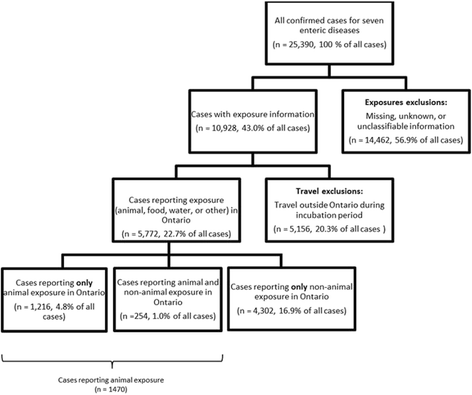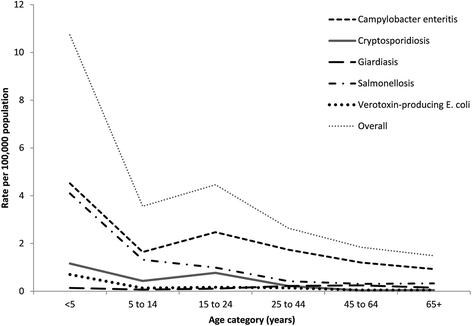Descriptive study of enteric zoonoses in Ontario, Canada, from 2010 - 2012
- PMID: 28222719
- PMCID: PMC5320741
- DOI: 10.1186/s12889-017-4135-9
Descriptive study of enteric zoonoses in Ontario, Canada, from 2010 - 2012
Abstract
Background: Contact with animals and their environment has long been recognized as an important source of enteric zoonoses. However, there are limited data available on the burden of illness associated with specific types of animals in Canada. This study describes the overall burden of enteric zoonoses in Ontario, Canada from 2010 to 2012.
Methods: Confirmed cases of seven enteric zoonotic diseases (campylobacteriosis, cryptosporidiosis, giardiasis, listeriosis, salmonellosis, verotoxin-producing E. coli (VTEC) infection, and yersiniosis) with episode dates from 2010 to 2012 were extracted from the integrated Public Health Information System (iPHIS). Reported exposures were categorized as animal contact, foodborne, waterborne and 'other', with animal contact grouped into nine sub-categories based on the type of animal or transmission setting. Overall incidence rates and proportions by animal exposure categories, age and sex-specific incidence rates and hospitalization and death proportions were calculated and sex proportions compared.
Results: Our study found that approximately 26% of the enteric pathogens assessed during the 2010 to 2012 period reported contact with animals and their environments as the mode of transmission. Of enteric disease cases reporting animal contact, farm exposures were reported for 51.3%, dog or cat exposures for 26.3%, and reptile or amphibian exposures for 8.9%.
Conclusions: Contact with animals was reported more frequently during the period 2010 to 2012 in comparison to the period 1997 to 2003 when 6% or less of enteric cases were associated with animal contact. Public health professionals, stakeholders associated with animals and their related industries (e.g., pet treats, mobile zoos, abattoirs), and the public should recognize that animal contact is an important source of enteric illnesses in order to take measures to reduce the burden of illness from animal sources.
Keywords: Animals; Enteric; Exposures; Illness; Zoonoses.
Figures
Similar articles
-
A descriptive study of reportable gastrointestinal illnesses in Ontario, Canada, from 2007 to 2009.BMC Public Health. 2012 Nov 12;12:970. doi: 10.1186/1471-2458-12-970. BMC Public Health. 2012. PMID: 23145487 Free PMC article.
-
Measuring animal exposure in Canada: Foodbook study, 2014-2015.Zoonoses Public Health. 2018 Nov;65(7):859-872. doi: 10.1111/zph.12510. Epub 2018 Sep 19. Zoonoses Public Health. 2018. PMID: 30230236
-
Farm Fairs and Petting Zoos: A Review of Animal Contact as a Source of Zoonotic Enteric Disease.Foodborne Pathog Dis. 2017 Feb;14(2):59-73. doi: 10.1089/fpd.2016.2185. Epub 2016 Dec 19. Foodborne Pathog Dis. 2017. PMID: 27992253 Review.
-
Estimating the Relative Role of Various Subcategories of Food, Water, and Animal Contact Transmission of 28 Enteric Diseases in Canada.Foodborne Pathog Dis. 2016 Feb;13(2):57-64. doi: 10.1089/fpd.2015.1957. Foodborne Pathog Dis. 2016. PMID: 26863428 Free PMC article.
-
Disease Risk Assessments Involving Companion Animals: an Overview for 15 Selected Pathogens Taking a European Perspective.J Comp Pathol. 2016 Jul;155(1 Suppl 1):S75-97. doi: 10.1016/j.jcpa.2015.08.003. Epub 2015 Sep 28. J Comp Pathol. 2016. PMID: 26422413 Review.
Cited by
-
Dairy Cattle Density and Temporal Patterns of Human Campylobacteriosis and Cryptosporidiosis in New Zealand.Ecohealth. 2022 Jun;19(2):273-289. doi: 10.1007/s10393-022-01593-9. Epub 2022 Jun 10. Ecohealth. 2022. PMID: 35689151 Free PMC article.
-
Point-Of-Care or Point-Of-Need Diagnostic Tests: Time to Change Outbreak Investigation and Pathogen Detection.Trop Med Infect Dis. 2020 Sep 25;5(4):151. doi: 10.3390/tropicalmed5040151. Trop Med Infect Dis. 2020. PMID: 32992688 Free PMC article. Review.
-
Zoonotic potential and prevalence of Salmonella serovars isolated from pets.Infect Ecol Epidemiol. 2021 Sep 8;11(1):1975530. doi: 10.1080/20008686.2021.1975530. eCollection 2021. Infect Ecol Epidemiol. 2021. PMID: 34531964 Free PMC article. Review.
-
Salmonella Vitkin Outbreak Associated with Bearded Dragons, Canada and United States, 2020-2022.Emerg Infect Dis. 2024 Feb;30(2):225-233. doi: 10.3201/eid3002.230963. Emerg Infect Dis. 2024. PMID: 38270159 Free PMC article. Review.
-
Estimates of healthcare utilisation and deaths from waterborne pathogen exposure in Ontario, Canada.Epidemiol Infect. 2020 Mar 13;148:e70. doi: 10.1017/S0950268820000631. Epidemiol Infect. 2020. PMID: 32167443 Free PMC article.
References
-
- Ontario Agency for Health Protection and Promotion (Public Health Ontario) Reportable disease trends in Ontario, 2011. Toronto: Queen’s Printer for Ontario; 2014.
-
- Rajda Z, Middleton D. Descriptive epidemiology of enteric illness for selected reportable diseases in Ontario, 2003. Can Commun Dis Rep. 2006;32(23):275–285. - PubMed
MeSH terms
LinkOut - more resources
Full Text Sources
Other Literature Sources
Medical
Miscellaneous



